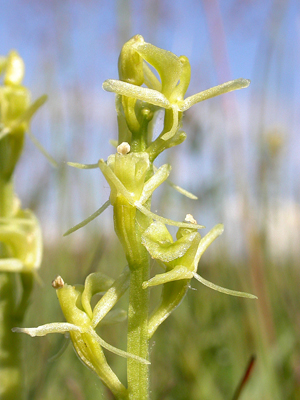UK: Getting the sands moving again
26.08.11
Britain's unique coastal dune flora will receive some help this year as Plantlife try to get them moving again as they begin a novel three year project on the dunes of South Wales.
As Andy Byfield, Plantlife’s Landscape Conservation Manager who is leading the project, visited Kenfig Burrows in South Wales recently, a site of European importance, explained:
 “I’ve just found some fen orchids, which I’m delighted about. In the 1980s, seven sites around the Bristol channel supported perhaps as many as 100,000 orchids but today this has declined to a single site of only about 400 plants, which shows why this project is so critical. This project, generously funded by the Esmée Fairbairn Foundation, is not about re-establishing moving dune systems within the wider landscape but aims to demonstrate how and why things need to be done differently to help these special species at our trial sites.”
“I’ve just found some fen orchids, which I’m delighted about. In the 1980s, seven sites around the Bristol channel supported perhaps as many as 100,000 orchids but today this has declined to a single site of only about 400 plants, which shows why this project is so critical. This project, generously funded by the Esmée Fairbairn Foundation, is not about re-establishing moving dune systems within the wider landscape but aims to demonstrate how and why things need to be done differently to help these special species at our trial sites.”
Fen orchid © David Carrington
Sand dunes are complex, unstable systems that are naturally mobile, supporting a specialist flora that prefers the bare, calcium-rich sand. Over the centuries, however, we have artificially and naturally stabilised Britain’s dunes with a devastating effect on our biodiversity. Plantlife will be working initially at Kenfig Burrows in partnership with Bridgend County Borough Council and the Countryside Council for Wales, and hopes to extend the project’s influence to other sites around the Bristol Channel.
A bit of information about Kenfig Burrows:
- One of the last remnants of huge dune systems that once stretched along the coast of Swansea Bay.
- It supports a variety of plants and fungi in the dunes, saltmarsh, swamp woodland and scrub, including 100% of the UK population of the dune variant of fen orchid.
- Only 2% of the dune system at Kenfig now comprises bare sand, down from around 40% in the mid 1940s. Early plant colonists including sea rocket, sea holly and yellow horned-poppy need bare sand to colonise – and these suffer if a dune system becomes too stable.
- Regular ground disturbance and open patches of sand will reduce the dominance of vigorous plant species and allow rarer, less vigorous species to return. As well as fen orchid, other declining species which will benefit include round leaved-wintergreen, marsh helleborine and early marsh orchid.
- Plantlife will be introducing trial management work aimed at encouraging fen orchid and allowing better conditions for many other species including the rare dune bryums and petalwort to develop.
Related links:
UK: Where to go to see orchids this year
07.04.11
![]() Few can resist the alluring sight of an orchid so to celebrate this the Wildlife Trusts have put together an online guide to 40 of the best sites in the UK to see these remarkable flowers.
Few can resist the alluring sight of an orchid so to celebrate this the Wildlife Trusts have put together an online guide to 40 of the best sites in the UK to see these remarkable flowers.
UK IN PICTURES: Botanical rarities from Breckland
03.12.10
![]() Plantlife - the plant conservation charity - are working to protect nine priority species in the extraordinary Breckland landscape. Here's a few photos of some of their target species.
Plantlife - the plant conservation charity - are working to protect nine priority species in the extraordinary Breckland landscape. Here's a few photos of some of their target species.
UK: Glorious diversity found in ancient farming landscape
02.12.10
 In the far east of England on the border between the counties of Norfolk and Suffolk lies a piece of land called Breckland. It's been known for a long time that Breckland has some rather special natural history but a recent study has shown just how important it really is.
In the far east of England on the border between the counties of Norfolk and Suffolk lies a piece of land called Breckland. It's been known for a long time that Breckland has some rather special natural history but a recent study has shown just how important it really is.